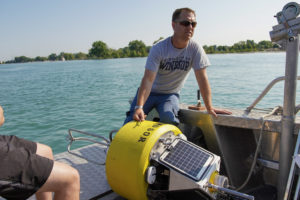The Great Lakes have gone through many ups and downs over the years — particularly Lake Erie. In the 1960s, it was declared “dead” due to pollution and eutrophication. The ’80s brought invasive zebra mussels. Today, the region faces multiple stressors: climate change, urban stormwater, industrial contaminants and toxic algae blooms.
Through it all, researchers at University of Windsor — OWC’s newest member — have been tackling those challenges. And the university’s Great Lakes Institute for Environmental Research (GLIER) has led the charge.
For more than 40 years, the Institute has brought together fisheries biologists, evolutionary ecologists, freshwater restoration experts, engineers and other investigators to understand the problems facing the lakes and their watersheds — and freshwater systems more broadly. “It’s been one of the flagship programs of the University,” says GLIER’s director, Michael McKay.
Developing smart monitoring solutions
Today, one of GLIER’s goals is to make the Great Lakes “smarter” through the Real-time Aquatic Ecosystem Observation Network (RAEON): a project funded by the Canada Foundation for Innovation and led by Aaron Fisk, Canada Research Chair in Changing Great Lakes Ecosystems.
In the past, monitoring water quality meant heading out on boats to collect samples. But that kind of sporadic spot testing isn’t just costly and time-consuming. It’s also not particularly accurate. “Lakes are very dynamic,” McKay explains. “So taking a sample today may not be reflective of what the condition is tomorrow.”
To overcome those shortcomings, RAEON is building a network of remote sensors installed on buoys. By providing real-time data, these sensors allow researchers, governments and companies to better forecast and respond to aquatic threats.
GLIER is also a major Canadian partner in the bi-national Smart Great Lakes Initiative, enhancing freshwater monitoring and conservation through sensors, AI and other data-driven solutions.
Digging into eDNA
 Data plays a big role in managing fisheries as well, where reliable information on stock sizes and distribution is crucial. Traditionally, that meant hauling up a net-full of fish and identifying them one by one.
Data plays a big role in managing fisheries as well, where reliable information on stock sizes and distribution is crucial. Traditionally, that meant hauling up a net-full of fish and identifying them one by one.
Environmental DNA (eDNA) technology is changing that. As fish swim through the water, they slough off skin cells containing genetic material. Scientists now have tools to extract that material from water samples and analyze it. “You can amplify [it] using genetic markers and identify species and sometimes even quantify the number of fish in the area,” says McKay.
Through GEN-FISH — the Genomic Network for Fish Identification, Stress and Health — GLIER researchers are leveraging this technology to monitor the health of freshwater fisheries in the Great Lakes and across Canada. As a result, the Genome Canada funded program is providing a more accurate picture of fish numbers, identifying trends and answering important questions.
Tracking ice, algae and coronavirus
While RAEON and GEN-FISH are the two biggest programs at GLIER, there’s plenty of other research going on at the Institute.
Take coronavirus, for example. When the pandemic hit, GLIER researchers teamed up with two prominent environmental engineers at University of Windsor — Rajesh Seth and Nihar Biswas — to track COVID-19 levels in wastewater.
Other investigators are monitoring algal blooms. These blooms can produce toxins that threaten drinking water supplies. Then, as the algae decomposes, they consume oxygen, creating “dead spots” in the lake. So GLIER researchers have worked with communities to install algae-tracking sensors at water intake pipes around Lake Erie.
Meanwhile, with the help of Coast Guard icebreakers, McKay is collecting water samples to understand what happens in the Great Lakes during the colder months. “For a long time, people just thought there’s nothing going on. It’s cold. It’s dark. It doesn’t really matter,” he says. “And we’re finding that no, actually, it’s quite dynamic in the winter as well.”
Training a new generation of water scientists
 GLIER is also home to FishCAST: the Fisheries Management and Conservation Careers in Science and Technology program. This unique initiative helps equip graduate students across Canada for jobs in restoration ecology, fisheries biology and aquatic sciences.
GLIER is also home to FishCAST: the Fisheries Management and Conservation Careers in Science and Technology program. This unique initiative helps equip graduate students across Canada for jobs in restoration ecology, fisheries biology and aquatic sciences.
Funded through NSERC’s Collaborative Research and Training Experience program, FishCAST offers internships, specialized field courses, and professional and technical workshops led by investigators from Windsor and across the country.
The OWC advantage: stronger together
That kind of collaborative approach is baked into GLIER. The institute brings together faculty from across the university, as well as government scientists, private-sector researchers and investigators from other universities.
Now that the University of Windsor is part of OWC, McKay is looking forward to forging even more of those fruitful collaborations. “We’re a medium-sized university,” he adds. “And so sometimes not all the resources that may be available to other larger schools will be available to us. But by being members of these consortiums, we get the benefit of that larger membership.”
Of course, those benefits go both ways. Welcoming the University of Windsor into OWC expands the expertise within our consortium and opens up a host of new partnership possibilities.




